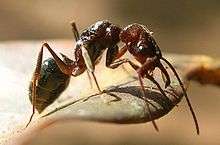Odontomachus
| Odontomachus | |
|---|---|
 | |
| Odontomachus from India | |
| Scientific classification | |
| Kingdom: | Animalia |
| Phylum: | Arthropoda |
| Class: | Insecta |
| Order: | Hymenoptera |
| Family: | Formicidae |
| Subfamily: | Ponerinae |
| Tribe: | Ponerini |
| Genus: | Odontomachus Latreille, 1804 |
| Type species | |
| Formica haematoda | |
| Diversity[1] | |
| 69 species | |
| Synonyms | |
|
Champsomyrmex Emery, 1892 | |
Odontomachus, or trap-jaw ants, is a genus of carnivorous ants found in the tropics and subtropics throughout the world.
Overview

Commonly known as trap-jaw ants, species in Odontomachus have a pair of large, straight mandibles capable of opening 180 degrees. These jaws are locked in place by an internal mechanism, and can snap shut on prey or objects when sensory hairs on the inside of the mandibles are touched. The mandibles are powerful and fast, giving the ant its common name. The mandibles either kill or maim the prey, allowing the ant to bring it back to the nest. Odontomachus can simply lock and snap its jaws again if one bite is not enough, or to cut off bits of larger food. The mandibles also permit slow and fine movements for other tasks such as nest building and care of larvae.
Speed record
Trap-jaw ants of this genus have the fastest moving predatory appendages within the animal kingdom.[2] One study of Odontomachus bauri recorded peak speeds of between 126–230 kilometres per hour (78–143 mph), with the jaws closing within just 130 microseconds on average. The peak force exerted was in the order of 300 times the body weight of the ant and acceleration of 1 000 000 m/s² or 100 000 g. The ants were also observed to use their jaws as a catapult to eject intruders or fling themselves backwards to escape a threat.[2][3]
Mimicry
The jumping spider genus Enoplomischus seems to mimic this ant genus.[4]
Distribution
Odontomachus species are found in Central to South America, Asia, Australia, and Africa.[5]
In the United States, Odontomachus haematodus was "recorded in Alabama back in 1956. But now researchers have officially confirmed that the species has spread across the Gulf Coast, at least as far east as Pensacola, Florida."[6] In the past, "Odontomachus ruginodis was thought to be confined to the Orlando region"; however, Magdalena Sorger, a PhD candidate at North Carolina State University, "has confirmed a record of ruginodis more than a hundred miles north of Orlando, in Gainesville, Florida."[7] Odontomachus relictus, however, is only found in "endangered scrub habitat on central Florida’s ancient sand ridges."[8]
Species


- Odontomachus aciculatus F. Smith, 1863
- Odontomachus affinis Guerin-Meneville, 1844
- Odontomachus alius Sorger & Zettel, 2011
- Odontomachus allolabis Kempf, 1974
- Odontomachus angulatus Mayr, 1866
- Odontomachus animosus Smith, 1860
- Odontomachus assiniensis Emery, 1892
- Odontomachus banksi Forel, 1910
- Odontomachus bauri Emery, 1892
- Odontomachus biolleyi Forel, 1908
- Odontomachus biumbonatus Brown, 1976
- Odontomachus bradleyi Brown, 1976
- Odontomachus brunneus (Patton, 1894)
- Odontomachus caelatus Brown, 1976
- Odontomachus cephalotes Smith, 1863 (Indonesia, Australia, etc.)
- Odontomachus chelifer (Latreille, 1802)
- Odontomachus circulus Wang, 1993
- Odontomachus clarus Roger, 1861
- Odontomachus coquereli Roger, 1861
- Odontomachus cornutus Stitz, 1933
- Odontomachus desertorum Wheeler, 1915
- Odontomachus erythrocephalus Emery, 1890
- Odontomachus floresensis Brown, 1976 (Indonesia: Flores)
- Odontomachus fulgidus Wang, 1993
- Odontomachus granatus Wang, 1993
- Odontomachus haematodus (Linnaeus, 1758) (South America, introduced to Australia prior to 1876)
- Odontomachus hastatus (Fabricius, 1804)
- Odontomachus imperator Emery, 1887
- Odontomachus infandus Smith, 1858
- Odontomachus insularis Guérin-Méneville, 1844
- Odontomachus kuroiwae (Matsumura, 1912)
- Odontomachus laticeps Roger, 1861
- Odontomachus latidens Mayr, 1867
- Odontomachus latissimus Viehmeyer, 1914
- Odontomachus malignus Smith, 1859
- Odontomachus mayi Mann, 1912
- Odontomachus meinerti Forel, 1905
- Odontomachus montanus Stitz, 1925
- Odontomachus monticola Emery, 1892
- Odontomachus mormo Brown, 1976
- Odontomachus nigriceps Smith, 1860
- Odontomachus opaciventris Forel, 1899
- Odontomachus opaculus Viehmeyer, 1912
- †Odontomachus paleomyagra Wappler, Dlussky, Engel, Prokop & Knor, 2014[9]
- Odontomachus panamensis Forel, 1899
- Odontomachus papuanus Emery, 1887
- Odontomachus peruanus Stitz, 1933
- Odontomachus philippinus Emery, 1893
- †Odontomachus pseudobauri (De Andrade, 1994)
- Odontomachus relictus Deyrup & Cover, 2004
- Odontomachus rixosus Smith, 1857
- Odontomachus ruficeps Smith, 1858 (Australia)
- Odontomachus rufithorax Emery, 1911
- Odontomachus ruginodis Smith, 1937
- Odontomachus saevissimus Smith, 1858
- Odontomachus scalptus Brown, 1978
- Odontomachus schoedli Sorger & Zettel, 2011
- Odontomachus scifictus Sorger & Zettel, 2011
- Odontomachus silvestrii W.M. Wheeler, 1927
- Odontomachus simillimus F. Smith, 1858 (Australia, Fiji, etc.)
- †Odontomachus spinifer De Andrade, 1994
- Odontomachus spissus Kempf, 1962
- Odontomachus sumbensis Brown, 1976
- Odontomachus tensus Wang, 1993
- Odontomachus testaceus Emery, 1897
- Odontomachus troglodytes Santschi, 1914 (Africa, Madagascar, Inner Seychelles)
- Odontomachus turneri Forel, 1900 (Australia)
- Odontomachus tyrannicus Smith, 1859
- Odontomachus xizangensis Wang, 1993
- Odontomachus yucatecus Brown, 1976
References
- ↑ Bolton, B. (2014). "Odontomachus". AntCat. Retrieved 20 July 2014.
- 1 2 Patek SN, Baio JE, Fisher BL, Suarez AV (22 August 2006). "Multifunctionality and mechanical origins: Ballistic jaw propulsion in trap-jaw ants" (PDF). Proceedings of the National Academy of Sciences. 103 (34): 12787–12792. doi:10.1073/pnas.0604290103. PMC 1568925
 . PMID 16924120. Retrieved 7 June 2008.
. PMID 16924120. Retrieved 7 June 2008. - ↑ Ant Jaws Break Speed Record — Videos of Odontomachus jumping using its jaws
- ↑ Wesołowska, W. (2005). "A new species of Enoplomischus from Kenya (Araneae: Salticidae: Leptorchestinae)" (PDF). Genus. 16 (2): 307–311.
- ↑ Schmidt, C. A.; Shattuck, S. O. (2014). "The Higher Classification of the Ant Subfamily Ponerinae (Hymenoptera: Formicidae), with a Review of Ponerine Ecology and Behavior". Zootaxa. 3817 (1): 1–242. doi:10.11646/zootaxa.3817.1.1. PMID 24943802.
- ↑ "Powerful Trap-jaw Ants are Gaining Ground in the Southeastern United States". Entomology Today. 20 June 2014. Retrieved 20 June 2014.
One species called Odontomachus haematodus was unofficially recorded in Alabama back in 1956. But now researchers have officially confirmed that the species has spread across the Gulf Coast, at least as far east as Pensacola, Florida.
- ↑ "Powerful Trap-jaw Ants are Gaining Ground in the Southeastern United States". Entomology Today. 20 June 2014. Retrieved 20 June 2014.
As recently as a few years ago, another species called Odontomachus ruginodis was thought to be confined to the Orlando region, and points south. But now Sorger has confirmed a record of ruginodis more than a hundred miles north of Orlando, in Gainesville, Florida.
- ↑ "Powerful Trap-jaw Ants are Gaining Ground in the Southeastern United States". Entomology Today. 20 June 2014. Retrieved 20 June 2014.
Not all of the trap-jaw species are on the move, however. Sorger also studies Odontomachus relictus, a species that is found only in endangered scrub habitat on central Florida’s ancient sand ridges.
- ↑ An Online Catalog of the Ants of the World: O. paleomyagra
External links
| Wikimedia Commons has media related to Odontomachus. |
- Mississippi Entomology Museum: Pictures of worker and male O. haematodus
- Ant's super-fast bite is a built-in 'ejector seat'
- Ferocious ants bite like a bullet - BBC News, 21 August 2006. Elli Leadbeater. Retrieved 22 August 2006
- Man-trap jaws make ant fastest predator - Scotsman, 22 August 2006. John Von Radowitz. Retrieved 22 August 2006